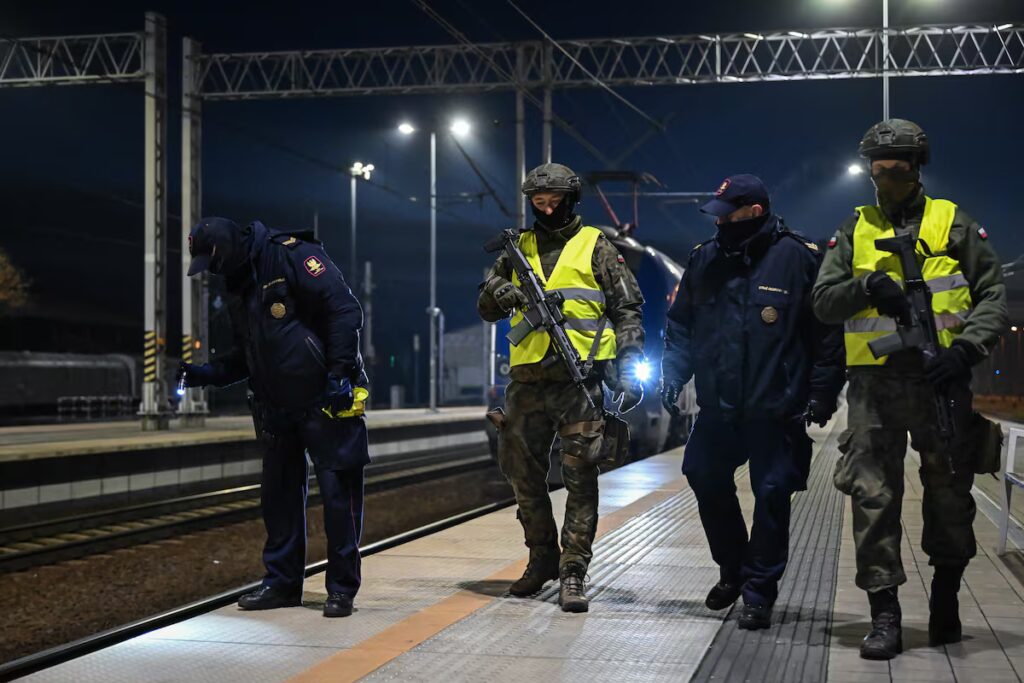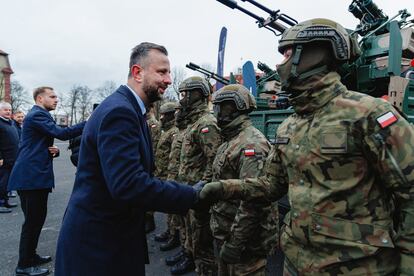
In Poland they claim that Russia is at war with the West and see themselves on the front line. It is not a conventional conflict with tanks, missiles, troops and deaths. It is that gray area where Moscow attacks from the shadows with covert operations, sabotage, cyber attacks and disinformation campaigns. The recent explosion of a railway line on a key route providing military aid to Ukraine is an example of the trend towards increasingly dangerous escalation in this hybrid warfare. While the West debates how to respond, the Kremlin watches and tries to gain ground.
Security and defense expert Tomasz Szatkowski, Poland’s permanent representative to NATO from 2019 to 2024, points out that his country “is probably the second most mentioned by Russian President Vladimir Putin in Europe after Ukraine.” He has “an obsession,” he says, with the wars of the 16th and 17th centuries in which Russia competed with Poland over Belarus and Ukraine.
Marek Menkiszak, head of the Russian department at the Center for Eastern Studies (OSW), a publicly funded think tank, agrees that “Poland is among the countries that Russia considers its main enemies.” Warsaw is one of the capitals most committed to supporting Ukraine, is a vital logistics center and gateway for NATO weapons into the attacked country and has a long history of confrontation with Moscow.
Geographic proximity also plays a role, facilitating the Kremlin’s operations. It has direct access to the country through the Russian enclave of Kaliningrad and Belarus, where the two Ukrainians suspected of railway sabotage entered and left.
After the mass expulsion of Russian diplomats to Europe after the invasion of Ukraine, including secret service agents (FSB and GRU), Moscow is increasingly recruiting intermediaries through different channels, such as Telegram. This allows you to broaden the scope of your actions and complicate attribution. The strategy also presents a favorable operational cost-benefit ratio for Russia: low-cost actions that force costly responses, such as mobilizing 10,000 Polish soldiers to protect critical infrastructure after sabotage.
The Kremlin’s hybrid actions are not new, but they have intensified across Europe since the start of the war in Ukraine. In Poland, media and analysts are currently examining the most worrying ones, such as the network that planned to attack trains carrying aid to Ukraine with explosives. Mysterious fires, including one that devastated a shopping mall in Warsaw in May 2024. Two months later, parcels sent via DHL and DPD exploded in several European countries, including Poland.
To kilka wybranych sabotaży, prób ingerencji, obserwacji, inwigilacji, etc, które opisuje w swooim nowym raporcie (wkrótce).
W kontekście “ataku”, gdzie ktoś zginie, to przypomnę, że żołnierz RP🇵🇱 zginął na granicy.
If you don’t get sick, if you don’t have anything, you’ll be happy. pic.twitter.com/anHHkUSpDG— Aleksander Olech (@Aleksander Olech) November 17, 2025
Experts have no doubt that Russia is behind these and other incidents, but it is difficult to prove this with certainty, as has been seen with drone overflights across Europe. Many of those recruited are Belarusians or Ukrainians, which, in addition to the space for denial, offers “an opportunity for another aspect of Russian cognitive warfare, which is divisive,” Szatkowski points out. One of Moscow’s main objectives is to undermine Western support for Ukraine and generate social confrontation, fear and distrust in institutions and the state.
With the Poles he encounters a visceral rejection of Russia after decades of Soviet domination. However, it seeks to undermine support for Ukraine – taking advantage of historic disputes between neighbors – with disinformation campaigns attributing some incidents to Kiev, such as the violation of its airspace with twenty bomb drones in September.
More aggressive attacks
So far none of the accidents have caused deaths, but they are increasingly dangerous. The attack on the railway infrastructure marked a leap in quality: explosives were used and the railway line was tampered with, putting a train with 475 passengers on board in serious danger. Radoslaw Sikorski, Polish Foreign Minister, called it “state terrorism”. As Alexander Lanoszka of the University of Waterloo in Canada points out, “Russia is taking the risk to the limit with this type of activity.”
Despite worsening hostilities in the hybrid territory, Moscow is experiencing limited consequences. In the West, the trend is towards de-escalation, the defense expert points out: “NATO leaders, including the Poles, are reluctant to do anything that could destabilize the region even more than it already is.”
The ambiguity of the gray zone allows authorities to circumscribe events such as criminal code sabotage and “avoid responsibility for the necessary actions that would be implied by any proclamation that this act is an act of violence or interstate subversion,” Lanoszka says. In these cases it is difficult to resort to Article 4 of the Alliance – which activates consultations when a member believes that its security is threatened – and even more so to Article 5, which establishes that an attack against one partner is an attack against all.
Even if the sabotage had ended in catastrophe, it would be unlikely that the 32 members of the Alliance would unanimously agree to retaliate for an accident of uncertain authorship. Szatkowski, who was also deputy defense minister in Warsaw, believes the allies would respond with defensive measures – “more planes in the air, more troops, whatever” – as they did with the launch of Operation Eastern Sentinel after the drone incident.
“It would probably be more realistic for a small coalition of countries to want to respond at some point simply to restore deterrence,” Szatkowski continues. In Poland, which leads NATO defense spending as a share of GDP and is approaching 5% in 2026, he believes some social pressure could emerge to act if a hybrid attack exceeds a certain threshold. “If you have built a deterrence strategy but do nothing, then you have failed: first by being attacked and then by failing to restore the credibility of deterrence.”
The answer dilemma
But responding militarily means entering the spiral of war. Moscow also often raises the specter of the nuclear threat. “Of course, it’s a bluff, but Russia knows that it resonates well in the West because people are afraid,” explains Menkiszak. Russia is carefully watching reactions to its operations, it warns. “If it is concluded that we are weak, that we are not willing to respond, that we try to avoid confrontation at almost any cost, this will cause further escalation,” says the OSW expert.
There are two possible lines of response, Menkiszak develops. The first is to strengthen the defenses, as Warsaw did. The Government has issued an alert in critical infrastructure, launched a citizen application to report suspicious activity and activated a campaign against disinformation, in an attempt to strengthen social resilience. However, the defensive option has limits. It is impossible to protect 100% of the rail network in a country the size of Poland or to protect the entire population from propaganda.
The second line of reaction is the offensive. “There will be no change in Russian behavior if we do not begin to respond offensively to their aggressive measures,” emphasizes Menkiszak, who is not specifically referring to the Polish case.
According to experts, there is still room for maneuver for Russia to feel the cost of its aggression more. They range from sanctions and more severe actions against the phantom fleet that illegally exports Russian crude oil to more radical sanctions, such as the closure of borders and all trade relations. In parallel, they advocate for a sustained increase in military support for Ukraine. After the incident, Warsaw announced that it would purchase weapons worth $100 million (86 million euros) for Kiev.

There is another, more controversial, range of retaliations, which falls within the logic of an eye for an eyesymmetrical retaliation. These would be actions such as orchestrating cyber counterattacks or sabotage on Russian soil, but they have no place in organizations such as the EU and NATO. “Inflicting damage in the gray zone is much more difficult to do in a democratic environment because these are essentially illegal measures. Of course the state intelligence services have a certain mandate for this, but the Russians have better tools,” warns Szatkowski.
“We have legal, political and capacity limitations that impact our ability to respond, because we also have to measure risks,” agrees OWS’s Menkiszak. “The fundamental dilemma is that democratic countries cannot and should not behave in the same way as totalitarian states.”
Moscow has better weapons and more room to maneuver in this hybrid war against the West, but is it winning? “If the goal is to discourage or reduce support for Ukraine, it has probably had some success, because Western military assistance has been irregular and uneven,” Lanoszka believes. “If it is causing panic and dividing public opinion, then I would be very reluctant to say that Russia is winning,” he says. The rise of ultra parties, another of Russia’s objectives, responds more to internal factors than to Russian influence, the analyst underlines.
In the Polish case, the society is already sufficiently polarized and divided without the need for Russians. But there is a risk of increasing distrust in infrastructures and institutions. The Kremlin has also managed to trigger a costly response – military deployment, weapons purchases – in the face of very cheap action. “But that’s only one side of the coin. The other is that we are learning and adapting,” Menkiszak emphasizes.
Polish authorities are preparing for winter. They know that the attacks will continue and that the darkness and the cold have always favored Moscow. The dilemma they must resolve, together with Western allies, is how to fight the adversary in that gray and slippery zone where every movement must balance deterrence, legality and the risk of escalation.





